

Hotels in the Valencian Community improved their 2024 figures in the first half of July, with average occupancy reaching 86.4%.
- The city of Valencia is the only destination with figures below those of 2024, although the gap has narrowed to 3 points.
- The sector is avoiding triumphalism and points out that 15% of the supply remains unsold.
The first major test of the 2025 summer season has yielded reasonably positive data in the Valencian Community. Average hotel occupancy across the entire region reached 86.4%, and all destinations have improved their figures compared to 2024, except for the city of Valencia, which remains three points behind last summer.
By destination, Benidorm once again leads the occupancy rate with 89.4% (a three-point increase), while the Costa Blanca has remained at 83.1% , up two points.
In Valencia, the results for the entire province are virtually the same as last summer, thanks to the boost from Valencia's sun and beach destinations. Average occupancy stood at 89.2% . However, the city of Valencia maintains this decline in occupancy, now reduced to three points, and has recorded a hotel occupancy rate of 86%.
Castellón also improved its hotel production, recording an average occupancy rate of 75.4 %, up two points compared to the first half of July 2024.
As usual, tourist demand also varies by destination.
While the international market dominates in Benidorm (59%) and the city of Valencia (67%), the domestic market 's influence and presence is noticeable in the rest of the destinations , with Castellón accounting for almost 88%.
Benidorm welcomes the Portuguese market, which is highly seasonal in the summer, but which emerges in this fortnight with a 5.4% share, while the Americans moderate their presence in Valencia with 8.9%. Confirmed reservations for the second half of July also indicate a moderate increase, which could be as low as 2 points compared to the 2024 figure.
The sector wants to avoid any triumphalism or hotel euphoria because, although the figures are slightly better than in 2024, approximately 15% of hotel capacity in the Valencian Community remains unsold, so there is no sense of fullness or saturation in Valencian hotels. This unoccupied capacity amounts to 25% in Castellón and 30% in Alicante Sur, so it would be unwise to convey sensations of fullness or saturation that do not correspond to reality.
You can view the full report at the following link:
Fortnightly report on hotel occupancy evolution – 1st half of July 2025
Below, we offer a detailed analysis of hotel occupancy rates in different locations throughout the Valencian Community.
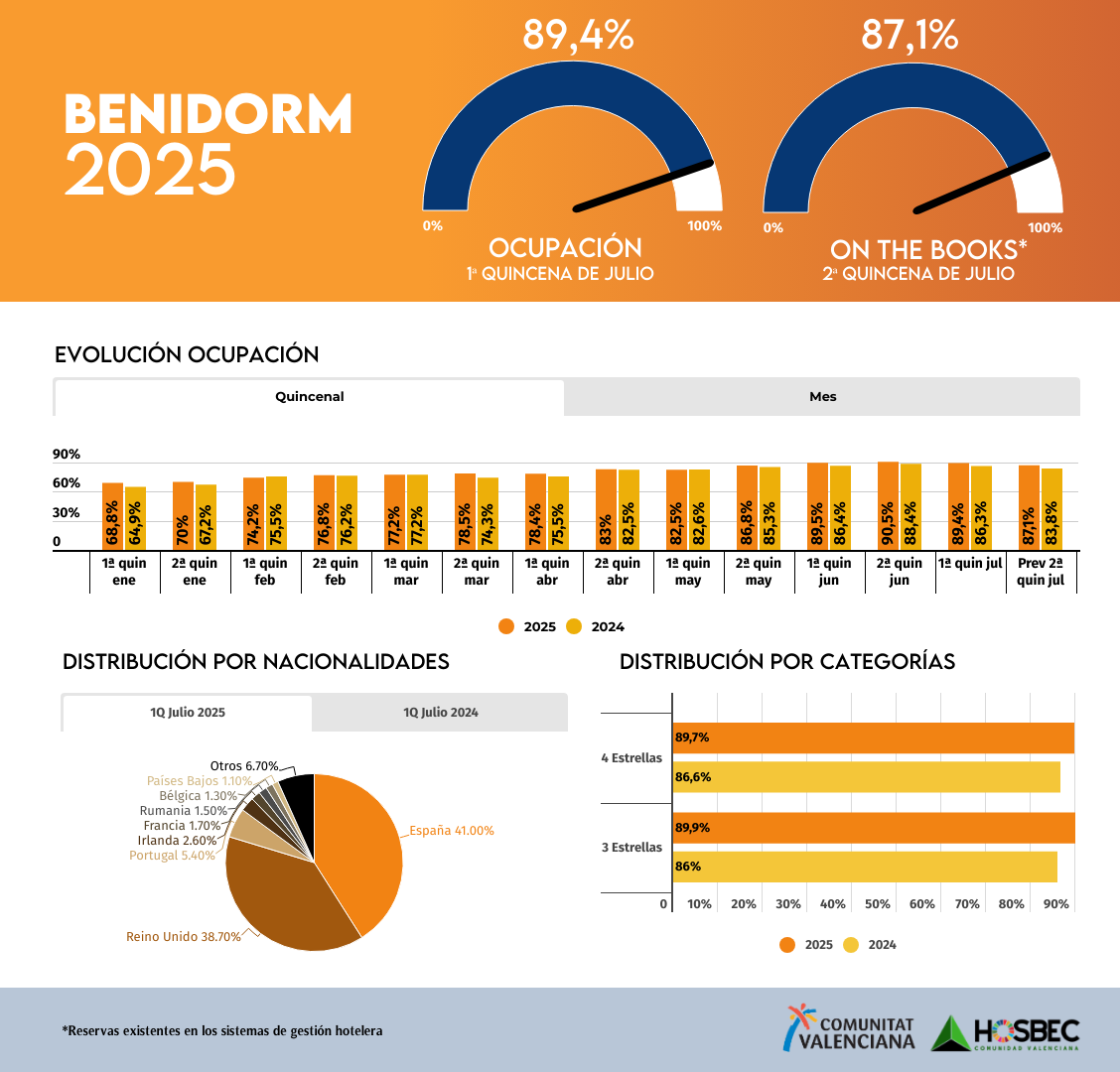
BENIDORM
Benidorm opens July with a bang, once again demonstrating why it remains one of the most established tourist destinations in the Mediterranean. The first half of July closed with an average occupancy rate of 89.4%, improving by more than three percentage points compared to the same period in 2024 (86.3%). This improvement also comes with a fully operational hotel portfolio, reinforcing the merit of the figure and demonstrating solid demand both nationally and internationally.
The Spanish market remains the destination's main driver, representing 41% of travelers staying in hotels. Close behind is the United Kingdom, which maintains its traditional loyalty to Benidorm with 38.7% , confirming its position as the main foreign source market. Portugal is gaining ground (5.4%) and consolidating its position as a key source during the high season, while Ireland (2.6%), France (1.7%), and Romania (1.5%) complete the group of notable nationalities. Belgium and the Netherlands also participate, with more modest but stable figures, within the destination's international profile.
In terms of category distribution, the data shows a very balanced performance : 4-star hotels reached 89.7% occupancy, while 3-star hotels even slightly exceeded it at 89.9%, both improving compared to the same period last year. This stability confirms the destination's consistent response across its entire accommodation offering.
Forecasts for the second half of July currently stand at 87.1% , a figure expected to be surpassed by last-minute bookings, common during the peak season. Benidorm is once again setting the pace for summer tourism in Valencia, combining loyalty, efficiency, and appeal.
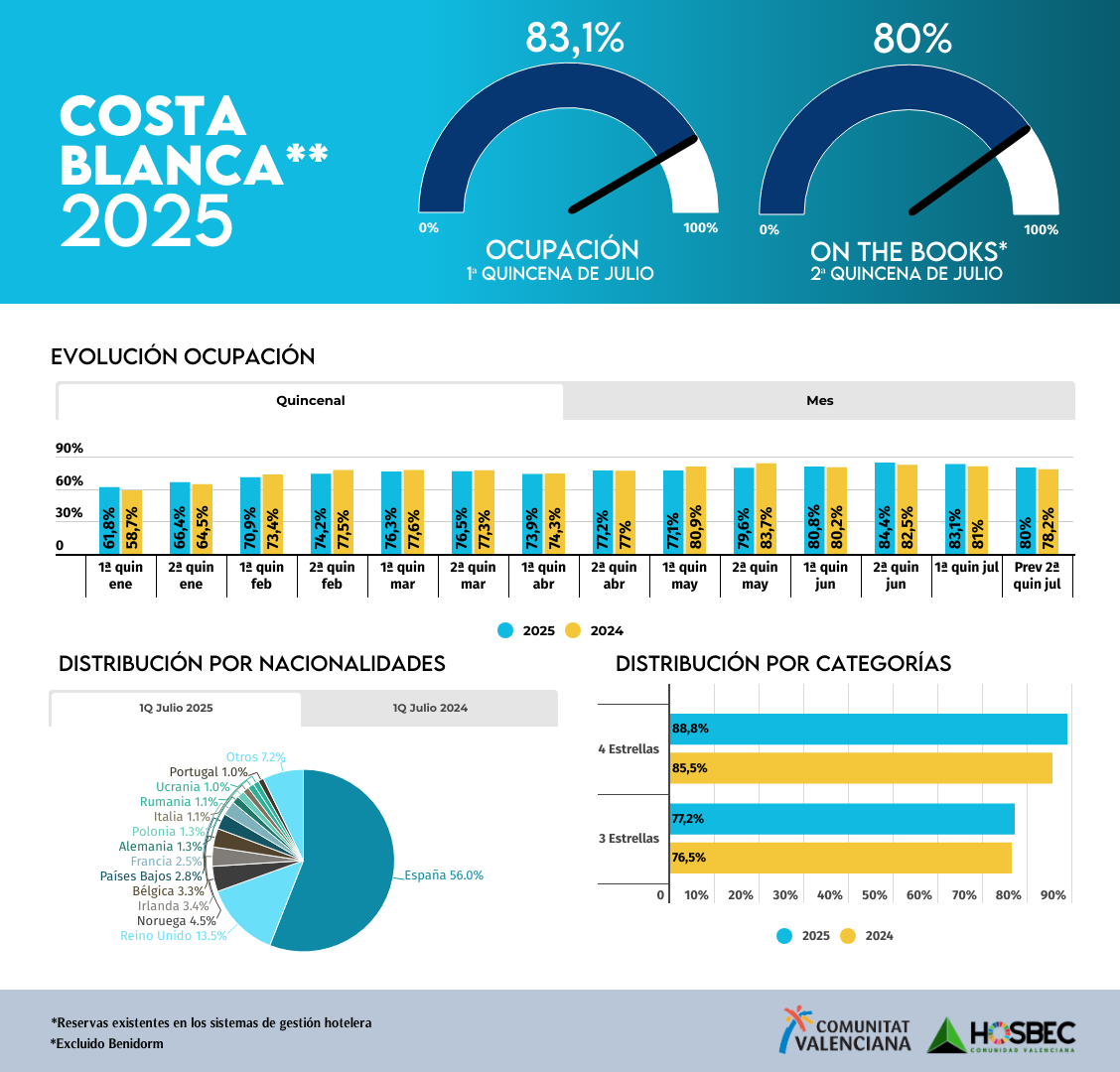
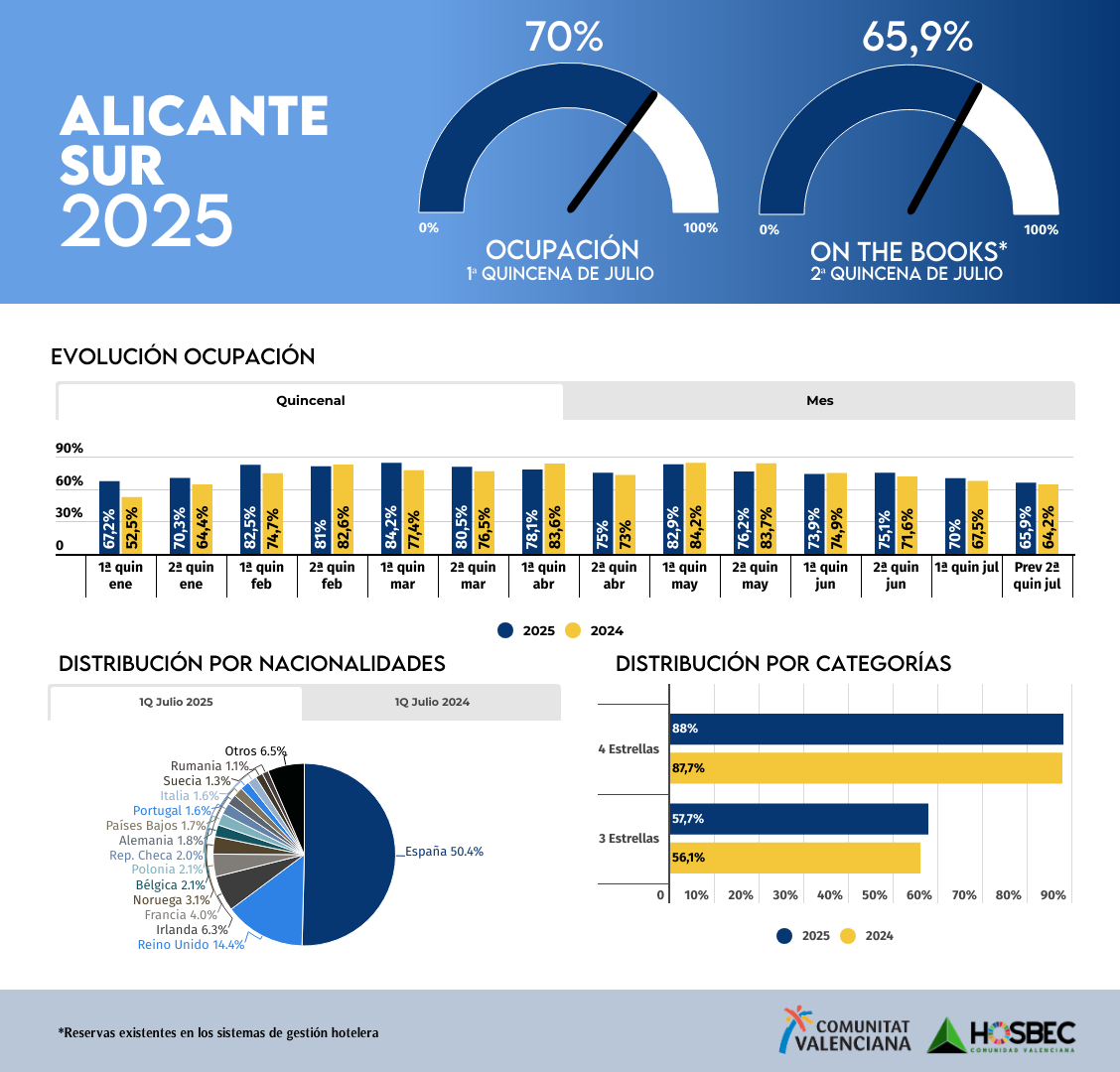
COSTA BLANCA AND ALICANTE SOUTH
TheCosta Blanca has started the first half of Julywith anaverage hotel occupancy rate of 83.1%, increasing by more than three points the figure recorded in 2024(80%) and maintaining an upward trend that confirms the good tone of the summer season. The 4-star hotel sector, which reached an outstanding 88.8% occupancy rate, leads the performance in the area, while 3-star hotels stand at 77.2%.
Domestic tourism remains the destination's mainstay, with a 56% share, although there has been a significant increase in international presence, particularly from the British market (13.5%) and northern European source countries such as Norway (4.5%), Ireland (3.4%), and Belgium (3.3%). This diversification consolidates the cosmopolitan profile of the Alicante coast.
In the analysis by region, the trend has also been positive in Alicante South, which has increased its occupancy rate to 70%, compared to 67.5% a year ago . Although the domestic market remains the predominant one (50.4%), the growth of outbound markets such as the United Kingdom (14.4%) and Ireland (6.3%) marks a clear increase in international tourism in this subregion . Other European markets, such as France, Norway, and Poland, are also gaining ground in a region that shows a more balanced distribution of nationalities than last season.
By category, 4-star hotels in South Alicante are showing high operational efficiency, with an occupancy rate of 88%, while 3-star hotels remain more lagging (57.7%), although they are also slightly improved compared to the previous year. The forecast for the second half of July is 80% for the Costa Blanca and 65.9% for South Alicante , which predicts a solid summer season in both areas.
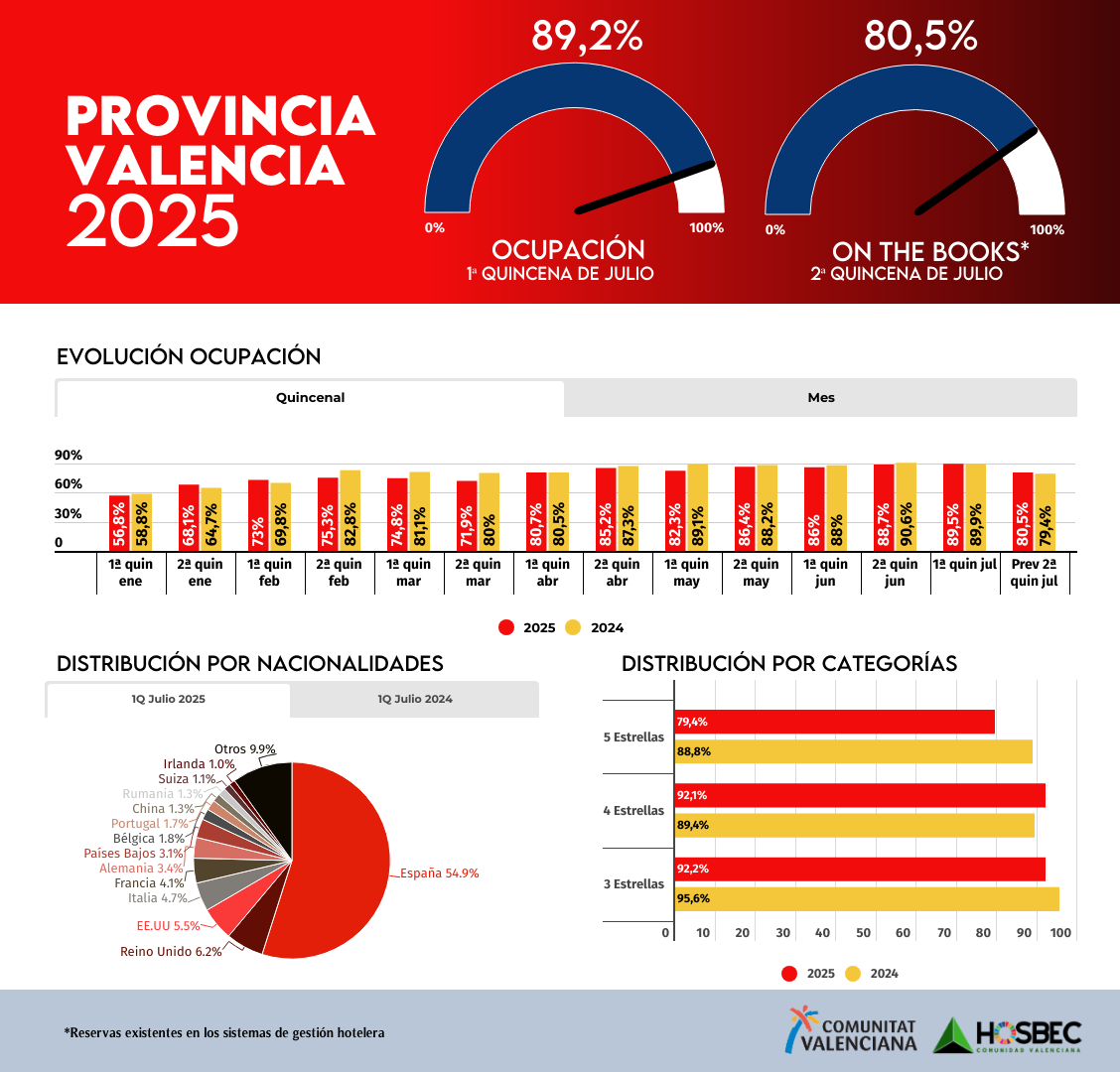
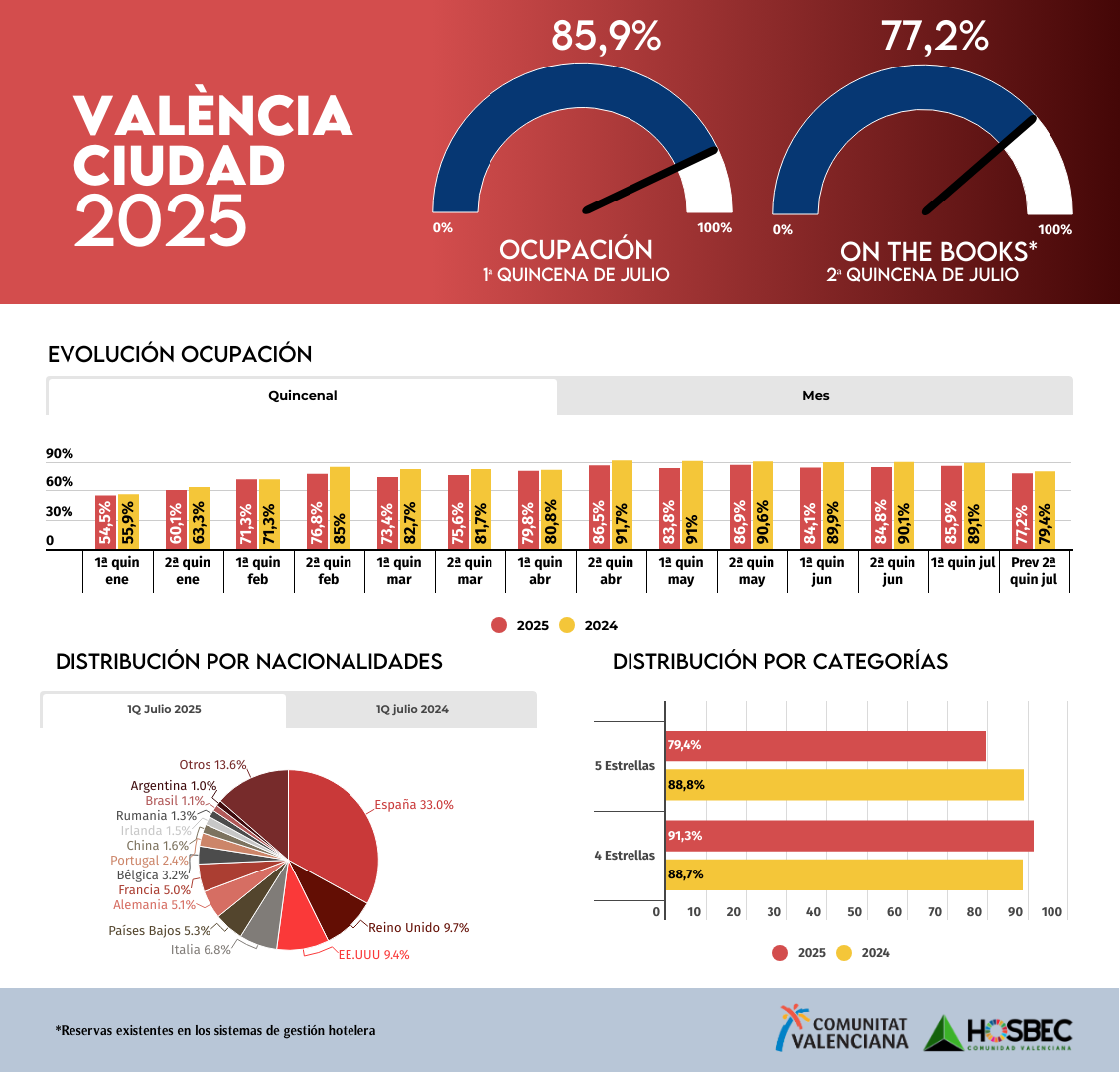
PROVINCE OF VALENCIA AND VALENCIA CITY
Theprovince of Valencia kicks off July with positive news: hotels have managed to achieve 89.2% occupancy in the first half of July,practically matching the excellent figure fromlast summer (89.9%). A result that is even more impressive considering that the effects of the DANA are still being felt in the destination. Furthermore, the forecast forthe second half of the month is already pointing upwards, with a confirmed 80.5% occupancy rate, exceeding expectations for the previous year at this point.
By category, performance has been particularly strong in 4- and 3-star hotels, which are close to full capacity with occupancy rates of 92.1% and 92.2% respectively. Although 5-star hotels have dropped to 79.4%, the destination as a whole shows remarkable strength in all market segments.
Domestic visitors remain the main customer (54.9%), but international markets are providing dynamism to the destination with clear growth: the United Kingdom (6.2%) and the United States (5.5%) continue to gain ground, followed by Italy, France, Germany and the Netherlands.
In Valencia city , hotel occupancy reached 85.9% in the first half of July, a figure that reflects the city's resilience in the face of the ongoing consequences of Hurricane Maria. Four-star hotels remain at the forefront, recording an excellent 91.3% occupancy rate.
The weight of domestic tourism fell slightly (33%), but the rise of international markets offset this decline, with a notable increase in visitors from the United Kingdom (9.7%), the United States (9.4%), Italy, Germany and the Netherlands.
Forecasts for the second half of the month point to continued positive tourism activity, with occupancy already secured at 77.2% , reinforcing the sector's confidence in a positive outlook for the rest of the summer.
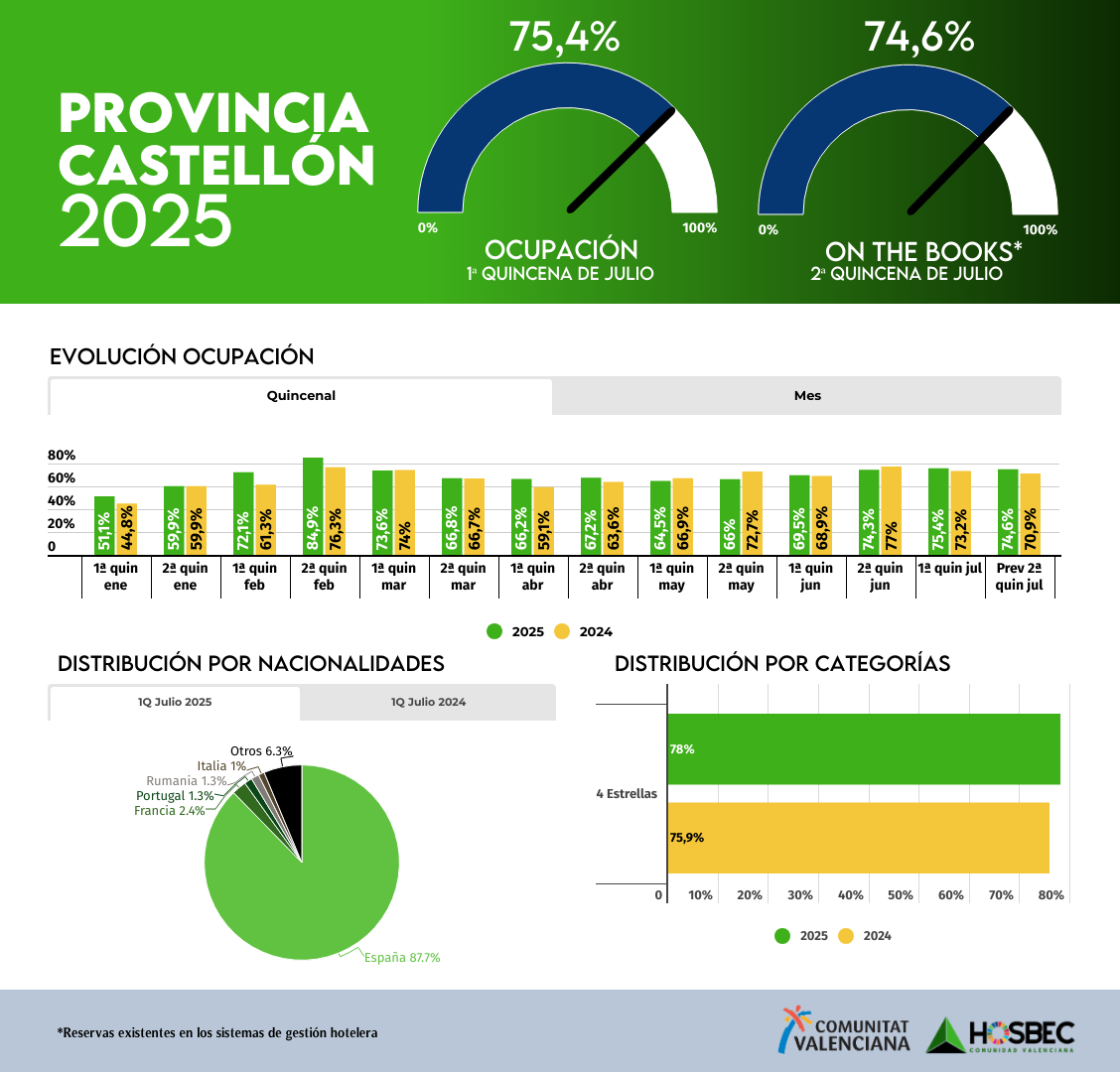
CASTELLÓN PROVINCE
Castellón has begun thefirst half of July with a hotel occupancy rate of75.4%, a figure thatimproves by more than two percentage points on the same period in 2024(73.2%). This increase confirms the positive response in demand in the middle of the summer season and marks a step forward for a destination that continues to gain momentum after a more restrained start to the year.
Domestic clientele remains the mainstay of tourism in the province, accounting for 87.7% of the total, a share virtually identical to last year (88.2%). Although international tourist numbers are still modest, there is a sustained presence from nearby markets such as France (2.4%) , Portugal (1.3%) , and Italy (1%) , complementing the pull of domestic tourism.
Furthermore, the predominant 4-star hotel offering in the area registered an occupancy rate of 78%, also improving on the previous year's figures (75.9%), reinforcing the destination's positive momentum in this first half of summer.
Looking ahead to the second half of the month, forecasts indicate an occupancy rate of 74.6% , significantly exceeding the 70.9% forecast for this time last year. These figures suggest a stable July, underscoring the industry's strong work to maintain the destination's appeal.
First for the latest UK & Spanish news on the hour every hour!

Latest Music Video's
Spain's More Music Variety










